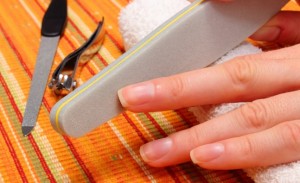
If you file your nails correctly, they will be less prone to splitting, snagging and peeling. Are you using the correct kind of nail file? How should you be filing your nails? See-saw motion, one direction only or from side to the middle on either side of the nail?
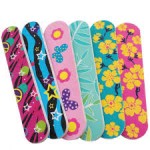 Firstly, you will need the right tool in order to file your nails correctly. At some point in our lives, we’ve all used one of those cheap, horrible, rough emery boards that feel like really coarse sandpaper. Yes, they may be cheap and they may come in cute patterns, funky colours and bulk packs but they will ruin your nails! They are far too coarse and harsh for filing down the natural nail.
Firstly, you will need the right tool in order to file your nails correctly. At some point in our lives, we’ve all used one of those cheap, horrible, rough emery boards that feel like really coarse sandpaper. Yes, they may be cheap and they may come in cute patterns, funky colours and bulk packs but they will ruin your nails! They are far too coarse and harsh for filing down the natural nail.
When looking for a nail file, you need to choose one according to grit (roughness). Files between 180-240 grit are best and the higher the number, the better. If you have healthy natural nails, a 240 grit file is perfect to use. Files with a higher grit will have a finer texture and will be less likely to rip or split your nails. It will also file off less with each motion, meaning that you won’t accidentally file off more than you want to.
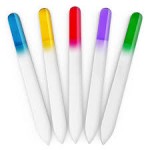 For “at home” use, there are many types of nail files to choose from:
For “at home” use, there are many types of nail files to choose from:
* Glass Files: These are sometimes called crystal nail files. They are very effective but can be difficult to find. If you want a glass file, look at online retailers or local beauty supply stores. If you live in New Zealand, you can purchase one from my online store.
* Emery boards or Nail Files: These are usually wooden or have a flexible plastic core with the relevant grit attached to either side (see grit list below).
* Avoid using metal nail files. These can tear your nails and cause splitting and delamination (peeling).
80 grit is very coarse and should never be used on natural nails.
100 grit is still very coarse but can safely be used on artificial nails or acrylic extensions only, never on natural nails.
180 grit is the lowest grit number that should be used on natural nails and is usually used on hard, tough nails (like toenails) or if your nails are really long and you need to shorten them a lot.
240 grit is a fine grit that makes the perfect file for filing and shaping natural nails.
280 grit is a little too fine for filing but can be used to remove any leftover snags after filing with 240 grit. It is also used as a buffer to smooth the surface of the nail.
400 grit is very soft and would be used to polish the natural nail before buffing.
4000 grit is usually sold as a (smooth) white nail buffer and is used to ‘shine’ the nails.
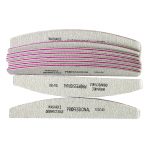 Before you start filing your nails, you need to decide on the nail shape that you want. There are lots of nail shapes to choose from, but here are 5 of the basics: Oval, Square, Squoval, Round and Almond. (See Nail Shapes article for a full list of different nail shapes with descriptions).
Before you start filing your nails, you need to decide on the nail shape that you want. There are lots of nail shapes to choose from, but here are 5 of the basics: Oval, Square, Squoval, Round and Almond. (See Nail Shapes article for a full list of different nail shapes with descriptions).
Before you file your nails, briefly wash your hands with soap and water to remove any hand cream and natural oils. Dry your hands and nails thoroughly. Avoid soaking your nails, as this will cause them to absorb water, making them soft, flexible and prone to tearing. If you are wearing nail polish and need to change it, remove the lacquer with nail polish remover after you’ve washed your hands. This will prevent your file from clogging up and will make the file last longer.
You’ve probably heard that you should always file your nails in one direction only or from the side to the tip of each nail. This may be true if you’re using a rough emery board, as these can rip and tear your nails and filing in one direction may reduce some of the tearing. If you’re using the correct tool (a 240 grit file or a glass file), the file will be soft and fine enough for you to use safely in a side-to-side motion, without doing any damage to your natural nails. Filing your nails this way will also be a lot quicker than filing in one direction only or filing each nail from side to middle on either side of the nail!
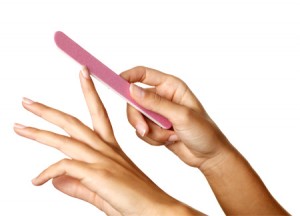
Don’t forget to file the sides of each nail in a straight, sweeping motion, to prevent them from splitting and snagging. Once you’re done, run your nails lightly along a piece of fabric (your shirt or trousers will do). If there are any snags left, they will catch slightly and you’ll be able to feel them. Simply file the snag down and your nails should be perfectly shaped.


Leave a Reply
You must be logged in to post a comment.